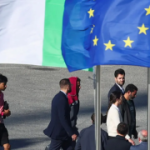In 1846 Nicholas I traveled privately to Rome to see Pope Gregory XVI and beg him not to give in to the liberal and republican temptations that were also asserting themselves in the Holy City. And the decision to “defend the values” of Christian Europe led him to the Crimean War. On the contrary, with the mission of “humanitarian diplomacy” of Card. Zuppi, today Pope Francis considers the world crisis in the light of the Gospel.
In some circumstances in the recent past politicians and scholars have used a term that arises more and more often in contemporary debate: “polycrisis“, which indicates the multiplicity of crises caused by wars, climate changes, pandemics, nuclear threats, migratory flows and many other things, in an interconnected and global decline. In 2022, the Financial Times awarded “policrisis” the title of “word of the year”, summarizing the interpretation of various specialists in the sense of “complex reciprocal relationship of world problems, antagonisms and crises.”
Adam Tooze, a historian at Columbia University, defined polycrisis even more broadly during the Covid-19 pandemic, as a “collective sense of disorientation” that derives from the awareness that global phenomena directly impact and immediate in the personal life of each one. Local or regional crises and conflicts have always been repeated in large numbers and have never disappeared, even when it seemed that we lived in a stable and peaceful world, but the globalization of recent decades has interconnected and intertwined them to the point of increasing each once again the joint impact.
One of the first to use the word polycrisis was the former president of the European Commission, Jean-Claude Juncker, who in 2016 considered that Europe was destabilized by the migration crisis that had caused the civil war in Syria, added to the economic collapse of Greece. , Russia’s annexation of Crimea and Brexit. The sense of global crisis largely derived from the collapse of the US stock markets in 2008-2009, which spread anxiety caused by a flawed and contradictory globalization, very different from the ideal “end of history” world that was believed to exist. reached.
Under these circumstances, Russia came into play, which seemed to have been reduced to a marginal role in the global balance, invading Georgia precisely in 2008. This also seemed to be a peripheral operation of little importance at the continental level, while today Europe finds itself harassed on all due to Russia’s conflicts in Ukraine and the Caucasus, and due to considerable tensions in the Baltic countries and Moldova. The already imminent elections in Tbilisi and Chisinau, the impossibility of definitively resolving the conflict between Armenia and Azerbaijan, the nuclear threats from the Kremlin and its Belarusian subject Alexander Lukashenko, this and many other things make Russia the main focus of the confusion caused by the polycrisis. Putin’s aggressive policy affects all factors: economic, social, ecological, political and cultural, which make it increasingly difficult to understand the future of peoples, institutions and people in Europe, Asia and the entire world.
The invasion of Ukraine has re-militarized the economies of many Western countries, as well as those of the former Soviet zone. Military spending by European countries has increased by 62% compared to 2014, as reported in Meduza’s Signal column, going from 330 to 552 billion euros. Before Putin’s war, one of the greatest tension factors came from the warnings of the then president of the United States, Donald Trump, to the Europeans for their low contribution to NATO expenses, threatening to cut American subsidies; and Trump could soon return to the White House, in a scenario in which NATO is increasingly decisive for the future of the entire West. In addition to the problems related to armaments, the Russian annexation of Crimea and the beginning of the hybrid war in Ukraine in 2014 have effectively destroyed confidence in the effectiveness of the norms of international law and the institutions delegated to enforce them, such as the UN, whose credibility is today at the lowest point since its founding, among other things due to issues related to the other war between Israel and Gaza.
The Russian blockade of the Black Sea in 2022 caused spikes in famine and hunger in the global South, as Ukraine is one of the world’s leading grain producers, covering around 10% of the market. The war in Ukraine has sparked the largest internal migration crisis in Europe since World War II, with hundreds of thousands of Ukrainians fleeing the war, but also waves of Russians who do not want to participate. In fact, there are 6.5 million Ukrainians and more than a million Russians who are outside their homeland.
Russian aggression against Ukraine also influences the climate crisis; The destruction of the Kakhovsk hydroelectric plant in the summer of 2023 destroyed the entire ecosystem of the region, to the point that many have used the term “ecocide” to describe it, which was invented in the ’70s to describe the devastation of the rainforests of Vietnam carried out by the United States Army. People and cities, watersheds and crop fields, animals and plants suffer because of war. Furthermore, Russia is an anti-leader in the ranking of environmental care even outside of war actions: it occupies third place for non-recycling of plastic, fourth for emissions of carbon dioxide into the atmosphere, third for oil production volumes. The lack of contribution from Russia, which even expelled Greenpeace and banned almost all environmental associations, makes it extremely difficult to face the problems of the climate crisis that in a few days will be discussed at Cop 29 in Baku, with the hope that friendship with the Azerbaijanis causes some remorse of conscience in the Russians.
It would give the impression that the polycrisis is not just a transitory phase linked to wars, and that when the conflicts are resolved (an outcome that is far from being realized) we can finally return to normality. For many observers, on the contrary, we are only at the beginning of an increasingly complex and widespread crisis, which at the end of the 1920s will show an extremely dangerous and inextricable panorama. Some consider that the polycrisis is not a casual phenomenon, but the result of the strategy of some world power centers, but it is known that abstract and conspiracy theories rather serve the guilty to evade their responsibilities, a propaganda operation in which Russians are masters.
Many blame globalizing turbo-capitalism, which they describe as a snake eating its own tail, which instead of universal prosperity has the effect of progressive destruction on a planetary level. We would be moving towards the cancellation of the human and its replacement by post-human virtual reality, which has yet to be defined. The insistence of Russians on “traditional moral values” is the mirror of “artificial digital values”, and reveals the inconsistency of both in a “polycritical” vision of the world. When the difficult situation of global relations began to be described, half a century ago, the population of the Earth was less than half of the current one, and new generations will have to bear the weight of a mass of people increasingly incapable to face the future, in addition to the desertification of many territories and the sinking of others.
Some historians refer the first sensation of polycrisis to the “bourgeois revolution” of the mid-19th century, when terror spread before the political and social changes that would disrupt the world, still structured on the basis of great empires and absolute powers. The Emperor of Russia, Nicholas I, was so scared that he began to defend all European autocracies, including those with which he was in conflict such as the Ottomans, to the point that he began to be called “the gendarme of Europe.” “. In May 1846, taking advantage of his wife’s healing stay in Sicily, he traveled privately to Rome to see Pope Gregory XVI and beg him not to give in to the liberal and republican temptations that were also taking over the Holy City. Russia then tried to affirm this will to “defend the values” of Christian Europe with the Crimean War of 1853-1856, which caused its isolation and resentment with the Western empires that did not want to join it in the conquest of Turkey and Middle East to the Holy Land, anticipating what is repeated today in the same territories, between Crimea and the Black Sea, and with the same motivations.
If at that time the tsar went to the Pope, today Pope Francis addresses Tsar Putin with the “humanitarian diplomacy” mission of Cardinal Matteo Maria Zuppi, who a few days ago met in Moscow with the Russian Minister of Foreign Affairs Sergei Lavrov . The Holy See does not aspire to become the “first mediator” in global military and political negotiations, nor is it only about helping deported children or tortured prisoners. The Church sees the world’s crisis in the light of the Gospel, which prepares it to face “wars and devastations” by exhorting not to lose faith in the salvation of the world through participation in the sacrifice of Christ. Building peace and helping the helpless are signs of concern for all humanity, which always needs to build a new world.
“RUSSIAN WORLD” IS THE ASIANEWS NEWSLETTER DEDICATED TO RUSSIA. DO YOU WANT TO RECEIVE IT EVERY SATURDAY IN YOUR EMAIL? SUBSCRIBE TO THE NEWSLETTER AT THIS LINK









Add Comment